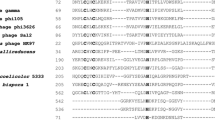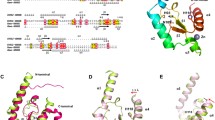Abstract
Thermostable enzymes from thermophiles have attracted extensive studies. However, little is known about thermophilic lysin of bacteriophage obtained from deep-sea hydrothermal vent. In this study, a lysin from deep-sea thermophilic bacteriophage Geobacillus virus E2 (GVE2) was characterized for the first time. It was found that the GVE2 lysin was highly homologous with N-acetylmuramoyl-L-alanine amidases. After expression in Escherichia coli, the recombinant GVE2 lysin was purified. The recombinant lysin was active over a range of temperature from 40 °C to 80 °C, with an optimum at 60 °C. Its optimal pH was 6.0, and it was stable over a wide range of pH from 4.0 to 10.0. The lysin was highly active when some enzyme inhibitors or detergents (phenylmethylsulfonyl fluoride, Tween 20, Triton X-100, and chaps) were used. However, it was strongly inhibited by sodium dodecyl sulfate and ethylene diamine tetraacetic acid. Its enzymatic activity could be slightly stimulated in the presence of Na+ and Li+. But the metal ions Mg2+, Ba2+, Zn2+, Fe3+, Ca2+, and Mn2+ at concentrations of 1 or 10 mM showed inhibitions to the lysin activity. Our study demonstrated the first characterization of lysin from deep-sea thermophilic bacteriophage.





Similar content being viewed by others
References
Baker JR, Liu CB, Dong SL, Pritchard DG (2006) Endopeptidase and glycosidase activities of the bacteriophage B30 lysin. Appl Envir Microbiol 72:6825–6828
Blondal T, Thorisdottir A, Unnsteinsdottir U, Hjorleifsdottir S, Aevarsson A, Ernstsson A (2005) Isolation and characterization of a thermostable RNA ligase 1 from a Thermus scotoductus bacteriophage TS2126 with good single-stranded DNA ligation properties. Nucleic Acids Res 33:135–142
Borysowski J, Dabrowska BW, Górski A (2006) Bacteriophage endolysins as a novel class of antibacterial agents. Exp Biol Med 231:366–377
Bradford MM (1976) A rapid sensitive method for the quantitation of microgram quantities of protein utilizing the principle of protein–dye binding. Anal Biochem 72:248–254
Colombo S, Auria SD, Fusi P, Zecca L, Raia CA, Tortora P (1992) Purification and characterization of a thermostable carboxypeptidase from the extreme thermophilic archaebacterium Sulfolobus solfataricus. Eur J Biochem 206:349–357
Delisle AL, Gerard JB, Guo M (2006) Isolation and expression of the lysis Genes of Actinomyces naeslundii phage Av-1. Appl Envir Microbiol 72:1110–1117
Dong G, Zeikus JG (1997) Purification and characterization of alkaline phosphatase from Thermotoga neapolitana. Enzyme Microb Technol 21:335–340
Entenza JM, Loeffler JM, Grandgirard D, Fischetti VA, Moreillon P (2005) Therapeutic effects of bacteriophage Cpl-1 lysin against Streptococcus pneumoniae endocarditis in rats. Antimicrob Agents Chemother 49:4789–4792
Kanaya S, Itaya M (1992) Expression, purification, and characterization of a recombinant ribonuclease H from Thermus thermophilus HB8. J Biol Chem 267:10184–10192
Kim WS, Salm H, Geider K (2004) Expression of bacteriophage øEa1h lysozyme in Escherichia coli and its activity in growth inhibition of Erwinia amylovora. Microbiology 150:2707–2714
Kozianowski G, Canganella F, Rainey FA, Hippe H, Antranikian G (1997) Purification and characterization of thermostable pectate-lyases from a newly isolated thermophilic bacterium, Thermoanaerobacter italicus sp. nov. Extremophiles 1:171–182
Liu B, Wu SJ, Song Q, **e LH, Zhang XB (2006) Two novel bacteriophages of thermophilic bacteria isolated from deep-sea hydrothermal fields. Curr Microbiol 53:163–166
Low LY, Yang C, Perego M, Osterman A, Liddington RC (2005) Structure and lytic activity of a Bacillus anthracis prophage endolysin. J Biol Chem 42:35433–35439
Mejjer WJJ, Horcajadas JA, Salas M (2001) ϕ29 family of phages. Microbiol Mol Biol Rev 65:261–287
Navarre WW, Ton TH, Faull KF, Schneewind O (1999) Multiple enzymatic activities of the murein hydrolase from staphylococcal phage f11. J Biol Chem 274:15847–15856
Nelson D, Schuch R, Chahales P, Zhu SW, Fischetti VA (2006) PlyC: a multimeric bacteriophage lysine. PNAS 103:10765–10770
O’Flaherty S, Coffey A, Meaney W, Fitzgerald GF, Ross RP (2005) The recombinant phage lysin LysK has a broad spectrum of lytic activity against clinically relevant staphylococci, including methicillin-resistant Staphylococcus aureus. J Bac 187:7161–7164
Ortmann AC, Suttle CA (2005) High abundances of viruses in a deep-sea hydrothermal vent system indicates viral mediated microbial mortality. Deep Sea Res Part I 52:1515–1527
Pritchard DG, Dong SG, Baker JR, Engler JA (2004) The bifunctional peptidoglycan lysin of Streptococcus agalactiae bacteriophage B30. Biochem Mol Biology 150:2079–2087
Shugar D (1952) The measurement of lysozyme activity and the ultra-violet inactivation of lysozyme. Biochim Biophys Acta 8:302–309
Suzuki T, Yasugi M, Arisaka F, Yamagishi A, Oshima T (2001) Adaptation of a thermophilic enzyme, 3-isopropylmalate dehydrogenase, to low temperatures. Protein Eng 14:85–91
Tomazic SJ, Klibanov AM (1988) Mechanisms of irreversible thermal inactivation of Bacillus a-amylases. J Biol Chem 263:3086–3091
Vieille C, Zeikus JG (2001) Hyperthermophilic enzymes: sources, uses, and molecular mechanisms for thermostability. Microbiol Mol Biol 65:1–43
Vieille C, Burdette DS, Zeikus JG (1996) Thermozymes. Biotechnol Annu Rev 2:1–83
Xu M, Struck DK, Deaton J, Wang IN, Young R (2004) A signal–arrest–release sequence mediates export and control of the phage p1 endolysin. PNAS 101:6415–6420
Young R (1992) Bacteriophage lysis: mechanism and regulation. Microbiol Rev 56:430–481
Zhao H, Arnold FH (1999) Directed evolution converts subtilisin E into a functional equivalent of thermitase. Protein Eng 12:47–53
Zimmer M, Vukov N, Scherer S, Loessner MJ (2002) The murein hydrolase of the bacteriophage f3626 dual lysis system is active against all tested Clostridium perfringens strains. Appl Environ Microbiol 68:5311–5317
Acknowledgements
This work was financially supported by National Natural Science Foundation of China (40576076), China Ocean Mineral Resources R & D Association (DYXM-115–02–2–15) and Hi-Tech Research and Development Program of China (863 program of China; 2007AA091407).
Author information
Authors and Affiliations
Corresponding author
Rights and permissions
About this article
Cite this article
Ye, T., Zhang, X. Characterization of a lysin from deep-sea thermophilic bacteriophage GVE2. Appl Microbiol Biotechnol 78, 635–641 (2008). https://doi.org/10.1007/s00253-008-1353-1
Received:
Revised:
Accepted:
Published:
Issue Date:
DOI: https://doi.org/10.1007/s00253-008-1353-1




